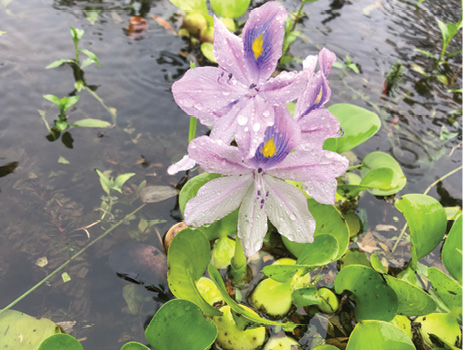Water Hyacinth | Pontederia crassipes
Floating | Non-Native

forming on the right.


Water hyacinth is a non-native, highly invasive species from Brazil. It has both free-floating and rooted forms. The floating growth form is particularly aggressive and can rapidly cover the water’s surface in a thick, heavy mat that can stand 3 feet tall.
This species is easily identified by its leathery, spongy, spoon-like leaves that feature parallel striations (wrinkles or ridges) along their length. Stems are spongy and buoyant, and smaller plants often have enlarged bulbous areas on stems that provide buoyancy. Young colonies can be misidentified as frog’s-bit; however, major veins will be evident in frog’s-bit leaves and will be absent in water hyacinth leaves.
The roots are purple to black and feathery. During the summer, the plant produces very showy, light-purple flowers with darker purple and yellow highlights.
The species can reproduce by seed but more commonly uses vegetative reproduction. Stolons (runners) extend horizontally and form new plants. This mode of reproduction is rapid and quickly produces mats that obstruct both human and wildlife use of water resources.
Management Value
Water hyacinth is extremely invasive and should never be introduced. It is not known to provide wildlife or fisheries benefits and can quickly cover the water’s surface and eliminate nearly all light penetration. Eradicate at first sight. Luckily, although it is very aggressive, it is also easily controlled in small ponds.
Recommended Controls
Option 1: 2,4-D (3.8-pound formulation). For each gallon of water, mix 0.75 ounce 2,4-D and 1.3 ounces non-ionic surfactant. Spray to wet all plants. Do not exceed annual herbicide rate limits as stated on the product label.
Option 2: Triclopyr (3.0-pound formulation). For each gallon of water, mix 0.5 ounce triclopyr and 1.3 ounces non-ionic surfactant. Spray to wet all plants. Do not exceed annual herbicide rate limits as stated on the product label.
Option 3: Imazamox (1.0-pound formulation). For each gallon of water, mix 0.5 ounce imazamox and 1.3 ounces non-ionic surfactant. Spray to wet all plants. Do not exceed annual herbicide rate limits as stated on the product label.
Option 4: Glyphosate (5.4-pound formulation). For each gallon of water, mix 1.0 ounce glyphosate and 1.3 ounces non-ionic surfactant. Spray to wet all plants. Do not exceed annual herbicide rate limits as stated on the product label.
When treating severe water hyacinth infestations, treat one-third of the pond at a time, with at least 2 weeks between applications. After the entire pond has been treated, a repeat whole-pond application may be necessary to eliminate remaining plants.
Read and follow all chemical label instructions, especially the section on the use of personal protection equipment.

The information given here is for educational purposes only. References to commercial products, trade names, or suppliers are made with the understanding that no endorsement is implied and that no discrimination against other products or suppliers is intended.
Publication 3735-45 (POD-11-23)
By Wes Neal, PhD, Extension/Research Professor, Wildlife, Fisheries, and Aquaculture; Dennis Riecke, Fisheries Coordinator, Mississippi Department of Wildlife, Fisheries, and Parks; and Gray Turnage, PhD, Assistant Research/Extension Professor, GeoSystems Research Institute.
The Mississippi State University Extension Service is working to ensure all web content is accessible to all users. If you need assistance accessing any of our content, please email the webteam or call 662-325-2262.



